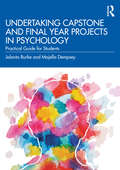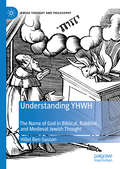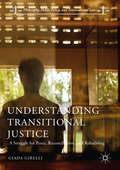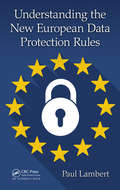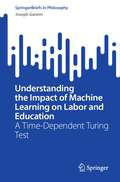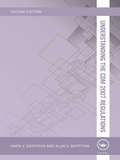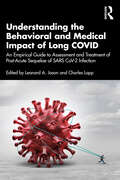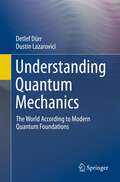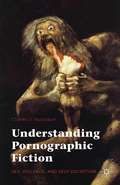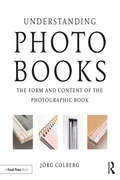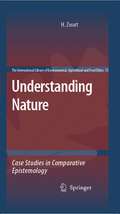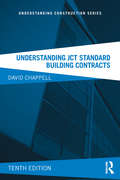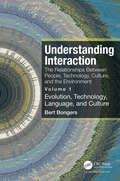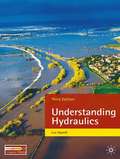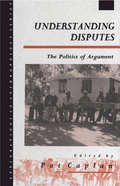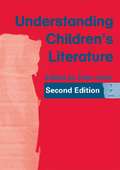- Table View
- List View
Undertaking Capstone and Final Year Projects in Psychology: Practical Guide for Students
by Jolanta Burke Majella DempseyUndertaking Capstone and Final Year Projects in Psychology serves a seminal purpose in guiding its readers to create a capstone project. The text employs traditional and emerging methodologies and methods in order to posit an exhaustive approach that the psychology students can adopt to see their project to fruition. The text aims at fortifying the reader’s skills through the structure of its chapters as they begin to work on their capstone or final year project. The chapters collectively explore the varied aspects that are involved in the completion of a final year project, that is, beginning from the inception of the idea to laying the foundation, designing the project, analysing the data, and, finally, presenting the findings. The text guides the reader through each step and provides further guidance on approaching the idea, coming up with the research question, positioning it within the epistemological and ontological context, and constructing the theoretical framework to arrive at the optimal design solutions. The text will be useful for psychology students who are currently completing a capstone or a final year project. It is further aimed at psychology students who will subsequently be working on a project and are looking forward to gaining cognisance regarding the approach and the methodology to be adopted for the same.
Undertaking Capstone and Final Year Projects in Psychology: Practical Guide for Students
by Jolanta Burke Majella DempseyUndertaking Capstone and Final Year Projects in Psychology serves a seminal purpose in guiding its readers to create a capstone project. The text employs traditional and emerging methodologies and methods in order to posit an exhaustive approach that the psychology students can adopt to see their project to fruition. The text aims at fortifying the reader’s skills through the structure of its chapters as they begin to work on their capstone or final year project. The chapters collectively explore the varied aspects that are involved in the completion of a final year project, that is, beginning from the inception of the idea to laying the foundation, designing the project, analysing the data, and, finally, presenting the findings. The text guides the reader through each step and provides further guidance on approaching the idea, coming up with the research question, positioning it within the epistemological and ontological context, and constructing the theoretical framework to arrive at the optimal design solutions. The text will be useful for psychology students who are currently completing a capstone or a final year project. It is further aimed at psychology students who will subsequently be working on a project and are looking forward to gaining cognisance regarding the approach and the methodology to be adopted for the same.
Understanding YHWH: The Name of God in Biblical, Rabbinic, and Medieval Jewish Thought (Jewish Thought and Philosophy)
by Hillel Ben-SassonThis book unlocks the Jewish theology of YHWH in three central stages of Jewish thought: the Hebrew bible, rabbinic literature, and medieval philosophy and mysticism. Providing a single conceptual key adapted from the philosophical debate on proper names, the book paints a dynamic picture of YHWH’s meanings over a spectrum of periods and genres, portraying an evolving interaction between two theological motivations: the wish to speak about God and the wish to speak to Him. Through this investigation, the book shows how Jews interpreted God's name in attempt to map the human-God relation, and to determine the measure of possibility for believers to realize a divine presence in their midst, through language.
Understanding Transitional Justice: A Struggle for Peace, Reconciliation, and Rebuilding
by Giada GirelliThe book is an accurate and accessible introduction to the complex and dynamic field of transitional and post-conflict justice, providing an overview of its recurring concepts and debated issues. Particular attention is reserved to how these concepts and issues have been addressed, both theoretically and literally, by lawyers, policy-makers, international bodies, and other actors informing the practice. By presenting significant, if undeniably disputable, alternatives to mainstream theories and past methods of addressing past injustice and (re)building a democratic state, the work aims to illustrate some foundational themes of transitional justice that have emerged from a diverse set of discussions. The author’s position thus arrives from a careful analysis of the advantages and disadvantages of answers to the question: how, after a traumatic social experience, is justice restored?
Understanding Transitional Justice: A Struggle for Peace, Reconciliation, and Rebuilding
by Giada GirelliThe book is an accurate and accessible introduction to the complex and dynamic field of transitional and post-conflict justice, providing an overview of its recurring concepts and debated issues. Particular attention is reserved to how these concepts and issues have been addressed, both theoretically and literally, by lawyers, policy-makers, international bodies, and other actors informing the practice. By presenting significant, if undeniably disputable, alternatives to mainstream theories and past methods of addressing past injustice and (re)building a democratic state, the work aims to illustrate some foundational themes of transitional justice that have emerged from a diverse set of discussions. The author’s position thus arrives from a careful analysis of the advantages and disadvantages of answers to the question: how, after a traumatic social experience, is justice restored?
Understanding the New European Data Protection Rules
by Paul LambertCompared to the US, European data and privacy protection rules seem Draconian. The European rules apply to any enterprise doing business in the EU. The new rules are far more stringent than the last set. This book is a quick guide to the directives for companies, particularly US, that have to comply with them. Where US organizations and businesses who collect or receive EU personal data fail to comply with the rule, the bottom line can suffer from very significant official fines and penalties, as well as from users, customers or representative bodies to pursuing litigation. This guide is essential for all US enterprises who directly or indirectly deal with EU personal data.
Understanding the New European Data Protection Rules
by Paul LambertCompared to the US, European data and privacy protection rules seem Draconian. The European rules apply to any enterprise doing business in the EU. The new rules are far more stringent than the last set. This book is a quick guide to the directives for companies, particularly US, that have to comply with them. Where US organizations and businesses who collect or receive EU personal data fail to comply with the rule, the bottom line can suffer from very significant official fines and penalties, as well as from users, customers or representative bodies to pursuing litigation. This guide is essential for all US enterprises who directly or indirectly deal with EU personal data.
Understanding the Impact of Machine Learning on Labor and Education: A Time-Dependent Turing Test (SpringerBriefs in Philosophy)
by Joseph GanemThis book provides a novel framework for understanding and revising labor markets and education policies in an era of machine learning. It posits that while learning and knowing both require thinking, learning is fundamentally different than knowing because it results in cognitive processes that change over time. Learning, in contrast to knowing, requires time and agency. Therefore, “learning algorithms”—that enable machines to modify their actions based on real-world experiences—are a fundamentally new form of artificial intelligence that have potential to be even more disruptive to labor markets than prior introductions of digital technology. To explore the difference between knowing and learning, Turing’s “Imitation Game,”—that he proposed as a test for machine thinking—is expanded to include time dependence. The arguments presented in the book introduce three novel concepts: (1) Comparative learning advantage: This is a concept analogous to comparative labor advantage but arises from the disparate times required to learn new knowledge bases/skillsets. It is argued that in the future, comparative learning advantages between humans and machines will determine their division of labor. (2) Two dimensions of job performance—expertise and interpersonal: Job tasks can be sorted into two broad categories. Tasks that require expertise have stable endpoints, which makes these tasks inherently repetitive and subject to automation. Tasks that are interpersonal are highly context-dependent and lack stable endpoints, which makes these tasks inherently non-routine. Humans compared to machines have a comparative learning advantage along the interpersonal dimension, which is increasing in value economically. (3) The Learning Game is a time-dependent version of Turing’s “Imitation Game.” It is more than a thought experiment. The “Learning Game” provides a mathematical framework with quantitative criteria for training and assessing comparative learning advantages. The book is highly interdisciplinary—presenting philosophical arguments in economics, artificial intelligence, and education. It also provides data, mathematical analysis, and testable criteria that researchers in these fields will find of practical use. The book calls for a rethinking of how labor markets operate and how the education system should prepare students for future jobs. It concludes with a list of counterintuitive recommendations for future education and labor policies that all stakeholders—employers, employees, educators, students, and political leaders—should heed.
Understanding the CDM 2007 Regulations (Understanding Construction)
by Owen V Griffiths Alun V GriffithsAlmost 3000 lives have been lost in the UK construction industry over the last twenty-five years, in addition to those seriously injured or made ill. The need to reduce this rate has required tight controls to be introduced throughout the planning and management of construction projects in the UK. The Construction (Design and Management) Regulations 2007 outline the responsibilities and liabilities for the various professionals and agents involved. Straightforward and practical, Understanding the CDM 2007 Regulations demonstrates the rationale behind the regs, covers the duties of the five core duty holders (client, CDM coordinator, designer, principal contractor and contractor), explains the importance of the hazard management process on every project and also sets out the consequences of failing to successfully plan, design and manage for safety. Any client, architect, engineer, CDM co-ordinator, project manager, construction professional, or student will find this a simple but thorough and dependable guide and should value the management toolkit and the numerous practical examples of best practice and guidance on how to use the Approved Code of Practice appropriately. This book shows how to unleash the potential of the regulations and add real value to the industry.
Understanding the CDM 2007 Regulations (Understanding Construction)
by Owen V Griffiths Alun V GriffithsAlmost 3000 lives have been lost in the UK construction industry over the last twenty-five years, in addition to those seriously injured or made ill. The need to reduce this rate has required tight controls to be introduced throughout the planning and management of construction projects in the UK. The Construction (Design and Management) Regulations 2007 outline the responsibilities and liabilities for the various professionals and agents involved. Straightforward and practical, Understanding the CDM 2007 Regulations demonstrates the rationale behind the regs, covers the duties of the five core duty holders (client, CDM coordinator, designer, principal contractor and contractor), explains the importance of the hazard management process on every project and also sets out the consequences of failing to successfully plan, design and manage for safety. Any client, architect, engineer, CDM co-ordinator, project manager, construction professional, or student will find this a simple but thorough and dependable guide and should value the management toolkit and the numerous practical examples of best practice and guidance on how to use the Approved Code of Practice appropriately. This book shows how to unleash the potential of the regulations and add real value to the industry.
Understanding the Behavioral and Medical Impact of Long COVID: An Empirical Guide to Assessment and Treatment of Post-Acute Sequelae of SARS CoV-2 Infection
by Leonard A. Jason and Charles LappUnderstanding the Behavioral and Medical Impact of Long COVID serves to expand the research around the illness in order to enable health care researchers and practitioners to address the questions that are imperative to individuals suffering from this condition. Through its multi-faceted approach, the book puts forth a maturation of research and interventions that are theoretically sound, empirically valid, innovative, and creative in the Long COVID area. As a scholarly and scientific compilation of Long COVID symptoms and related disorders, this book offers unparalleled insight into the critical developments across medical areas treating this illness. It helps to fill the space that the pandemic had created for knowledge of the condition, and contributes to the emerging emphasis on translational research blending the social sciences and biological fields. By putting forth the most optimal medical care practices in the treatment of complex Long COVID symptoms, this practical anthology will serve as a guide for practicing clinicians in assessment as well as treatment. It will also benefit researchers aiming to gain more understanding of Long COVID through its discussion around the critical developments in other medical areas treating the condition, and paves the way for the collaboration and future research needed to best support the global effort to mitigate the effects of this illness. This book will be essential reading for academics, practitioners, and researchers. It will appeal to individuals engaging with the fields of medicine, public policy, psychology, and for researchers looking to gain clarity about our current understanding of Long COVID. It will further be of interest to public/government agencies, nonprofit organizations, and the general public wanting to gain more information about these ambiguous and evasive symptoms.
Understanding the Behavioral and Medical Impact of Long COVID: An Empirical Guide to Assessment and Treatment of Post-Acute Sequelae of SARS CoV-2 Infection
Understanding the Behavioral and Medical Impact of Long COVID serves to expand the research around the illness in order to enable health care researchers and practitioners to address the questions that are imperative to individuals suffering from this condition. Through its multi-faceted approach, the book puts forth a maturation of research and interventions that are theoretically sound, empirically valid, innovative, and creative in the Long COVID area. As a scholarly and scientific compilation of Long COVID symptoms and related disorders, this book offers unparalleled insight into the critical developments across medical areas treating this illness. It helps to fill the space that the pandemic had created for knowledge of the condition, and contributes to the emerging emphasis on translational research blending the social sciences and biological fields. By putting forth the most optimal medical care practices in the treatment of complex Long COVID symptoms, this practical anthology will serve as a guide for practicing clinicians in assessment as well as treatment. It will also benefit researchers aiming to gain more understanding of Long COVID through its discussion around the critical developments in other medical areas treating the condition, and paves the way for the collaboration and future research needed to best support the global effort to mitigate the effects of this illness. This book will be essential reading for academics, practitioners, and researchers. It will appeal to individuals engaging with the fields of medicine, public policy, psychology, and for researchers looking to gain clarity about our current understanding of Long COVID. It will further be of interest to public/government agencies, nonprofit organizations, and the general public wanting to gain more information about these ambiguous and evasive symptoms.
Understanding Quantum Mechanics: The World According to Modern Quantum Foundations
by Detlef Dürr Dustin LazaroviciThis book discusses the physical and mathematical foundations of modern quantum mechanics and three realistic quantum theories that John Stuart Bell called "theories without observers" because they do not merely speak about measurements but develop an objective picture of the physical world. These are Bohmian mechanics, the GRW collapse theory, and the Many Worlds theory. The book is ideal to accompany or supplement a lecture course on quantum mechanics, but also suited for self-study, particularly for those who have completed such a course but are left puzzled by the question: "What does the mathematical formalism, which I have so laboriously learned and applied, actually tell us about nature?”
Understanding Pornographic Fiction: Sex, Violence, and Self-Deception
by Charles NussbaumThis work defends two main theses. First, modern Western pornographic fiction functions as a self-deceptive vehicle for sexual or blood-lustful arousal; and second, that its emergence owes as much to Puritan Protestantism and its inner- or this-worldly asceticism as does the emergence of modern rationalized capitalism.
Understanding Photobooks: The Form and Content of the Photographic Book
by Jorg ColbergUnderstanding Photobooks is a user-friendly guide to engaging with the photographic book— or, as it is widely known, the photobook. Despite its importance as a central medium in which many photographers showcase their work today, there is surprisingly little information on the mechanics of the photobook: what exactly it does and how it does it. Written for makers and artists, this book will help you develop a better understanding of the images, concept, sequence, design, and production of the photobook. With an awareness of the connections between these elements, you’ll be able to evaluate photobooks more clearly and easily, ultimately allowing for a deeper and more rewarding experience of the work.
Understanding Photobooks: The Form and Content of the Photographic Book
by Jorg ColbergUnderstanding Photobooks is a user-friendly guide to engaging with the photographic book— or, as it is widely known, the photobook. Despite its importance as a central medium in which many photographers showcase their work today, there is surprisingly little information on the mechanics of the photobook: what exactly it does and how it does it. Written for makers and artists, this book will help you develop a better understanding of the images, concept, sequence, design, and production of the photobook. With an awareness of the connections between these elements, you’ll be able to evaluate photobooks more clearly and easily, ultimately allowing for a deeper and more rewarding experience of the work.
Understanding Nature: Case Studies in Comparative Epistemology (The International Library of Environmental, Agricultural and Food Ethics #13)
by Hub ZwartScience is not the only route to understanding nature. This volume presents a series of case studies in comparative epistemology, critically comparing the works of prominent representatives of the life sciences, such as Aristotle, Darwin, and Mendel, with the writings of literary masters, such as Andersen, Melville, Verne, and Ibsen. It constitutes a major contribution to the growing field of science and literature studies.
Understanding JCT Standard Building Contracts (Understanding Construction)
by David ChappellThis tenth edition of David Chappell’s bestselling guide has been revised to take into account changes made in 2016 to payment provisions, loss and/or expense, insurance and many other smaller but significant changes, and includes a section on performance bonds and guarantees. This remains the most concise guide available to the most commonly used JCT building contracts: Standard Building Contract with quantities, 2016 (SBC16), Intermediate Building Contract 2016 (IC16), Intermediate Building Contract with contractor’s design 2016 (ICD16), Minor Works Building Contract 2016 (MW16), Minor Works Building Contract with contractor’s design 2016 (MWD16) and Design and Build Contract 2016 (DB16). Chappell avoids legal jargon and writes with authority and precision. Architects, quantity surveyors, contractors and students of these professions will find this a practical and affordable reference tool arranged by topic.
Understanding JCT Standard Building Contracts (Understanding Construction)
by David ChappellThis tenth edition of David Chappell’s bestselling guide has been revised to take into account changes made in 2016 to payment provisions, loss and/or expense, insurance and many other smaller but significant changes, and includes a section on performance bonds and guarantees. This remains the most concise guide available to the most commonly used JCT building contracts: Standard Building Contract with quantities, 2016 (SBC16), Intermediate Building Contract 2016 (IC16), Intermediate Building Contract with contractor’s design 2016 (ICD16), Minor Works Building Contract 2016 (MW16), Minor Works Building Contract with contractor’s design 2016 (MWD16) and Design and Build Contract 2016 (DB16). Chappell avoids legal jargon and writes with authority and precision. Architects, quantity surveyors, contractors and students of these professions will find this a practical and affordable reference tool arranged by topic.
Understanding Interaction: Volume 1: Evolution, Technology, Language and Culture
by Bert BongersUnderstanding Interaction explores the interaction between people and technology in the broader context of the relations between the human-made and the natural environments. It is not just about digital technologies – our computers, smartphones, the Internet – but all our technologies, such as mechanical, electrical, and electronic. Our ancestors started creating mechanical tools and shaping their environments millions of years ago, developing cultures and languages, which in turn influenced our evolution. Volume 1 looks into this deep history, starting from the tool-creating period (the longest and most influential on our physical and mental capacities) to the settlement period (agriculture, domestication, villages and cities, written language), the industrial period (science, engineering, reformation, and renaissance), and finally the communication period (mass media, digital technologies, and global networks). Volume 2 looks into humans in interaction – our physiology, anatomy, neurology, psychology, how we experience and influence the world, and how we (think we) think. From this transdisciplinary understanding, design approaches and frameworks are presented to potentially guide future developments and innovations. The aim of the book is to be a guide and inspiration for designers, artists, engineers, psychologists, media producers, social scientists, etc., and, as such, be useful for both novices and more experienced practitioners. Image Credit: Still of interactive video pattern created with a range of motion sensors in the Facets kaleidoscopic algorithm (based underwater footage of seaweed movement) by the author on 4 February 2010, for a lecture at Hyperbody at the Faculty of Architecture, TU Delft, NL.
Understanding Interaction: Volume 1: Evolution, Technology, Language and Culture
by Bert BongersUnderstanding Interaction explores the interaction between people and technology in the broader context of the relations between the human-made and the natural environments. It is not just about digital technologies – our computers, smartphones, the Internet – but all our technologies, such as mechanical, electrical, and electronic. Our ancestors started creating mechanical tools and shaping their environments millions of years ago, developing cultures and languages, which in turn influenced our evolution. Volume 1 looks into this deep history, starting from the tool-creating period (the longest and most influential on our physical and mental capacities) to the settlement period (agriculture, domestication, villages and cities, written language), the industrial period (science, engineering, reformation, and renaissance), and finally the communication period (mass media, digital technologies, and global networks). Volume 2 looks into humans in interaction – our physiology, anatomy, neurology, psychology, how we experience and influence the world, and how we (think we) think. From this transdisciplinary understanding, design approaches and frameworks are presented to potentially guide future developments and innovations. The aim of the book is to be a guide and inspiration for designers, artists, engineers, psychologists, media producers, social scientists, etc., and, as such, be useful for both novices and more experienced practitioners. Image Credit: Still of interactive video pattern created with a range of motion sensors in the Facets kaleidoscopic algorithm (based underwater footage of seaweed movement) by the author on 4 February 2010, for a lecture at Hyperbody at the Faculty of Architecture, TU Delft, NL.
Understanding Hydraulics (PDF)
by Leslie HamillCovering all the fundamental topics in hydraulics and hydrology, this text is essential reading for undergraduate students and practising engineers around the world who want an accessible, thorough and trusted introduction to the subject. By encouraging readers to work through examples, try simple experiments and continually test their own understanding as the book progresses, the text quickly builds confidence. This hands-on approach aims to show students just how interesting hydraulics and hydrology are, as well as providing an invaluable reference resource for practising engineers. Key features: an easy-to-read, engaging text a wealth of worked examples to reinforce the theory boxed highlights and Remember! features Self Test and Revision Questions with solutions a wide range of figures and photographs This third edition includes: Updates on climate change, flood risk management, flood alleviation, design considerations when developing greenfield sites, and the design of storm water sewers A new chapter on sustainable storm water management
Understanding Disputes: The Politics of Argument
by Pat CaplanAre disputes ever really resolved, or do people need to find ways of accommodating them and living with the consequences? Can dispute settlement procedures at the local level be transferred to wider environments? In attempting to answer these questions, some of the foremost specialists in the anthropology of law and disputing behaviour examine how people in a variety of social settings, ranging from Ireland to East Africa, deal with quarrels and seek to resolve or accommodate them. This stimulating volume should be of interest to anyone concerned about the increase in conflict in many parts of the world.
Understanding Disputes: The Politics of Argument (Explorations In Anthropology Ser.)
by Pat CaplanAre disputes ever really resolved, or do people need to find ways of accommodating them and living with the consequences? Can dispute settlement procedures at the local level be transferred to wider environments? In attempting to answer these questions, some of the foremost specialists in the anthropology of law and disputing behaviour examine how people in a variety of social settings, ranging from Ireland to East Africa, deal with quarrels and seek to resolve or accommodate them. This stimulating volume should be of interest to anyone concerned about the increase in conflict in many parts of the world.
Understanding Children's Literature: Key Essays From The International Companion Encyclopedia Of Children's Literature
by Peter HuntEdited by Peter Hunt, a leading figure in the field, this book introduces the study of children’s literature, addressing theoretical questions as well as the most relevant critical approaches to the discipline. The fourteen chapters draw on insights from academic disciplines ranging from cultural and literary studies to education and psychology, and include an essay on what writers for children think about their craft. The result is a fascinating array of perspectives on key topics in children’s literature as well as an introduction to such diverse concerns as literacy, ideology, stylistics, feminism, history, culture and bibliotherapy. An extensive general bibliography is complemented by lists of further reading for each chapter and a glossary defines critical and technical terms, making the book accessible for those coming to the field or to a particular approach for the first time. In this second edition there are four entirely new chapters; contributors have revisited and revised or rewritten seven of the chapters to reflect new thinking, while the remaining three are classic essays, widely acknowledged to be definitive. Understanding Children’s Literature will not only be an invaluable guide for students of literature or education, but it will also inform and enrich the practice of teachers and librarians.
